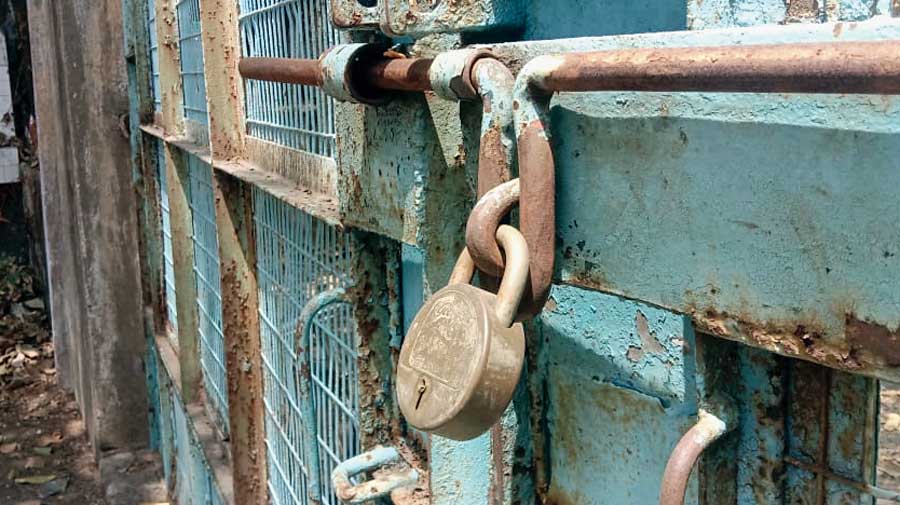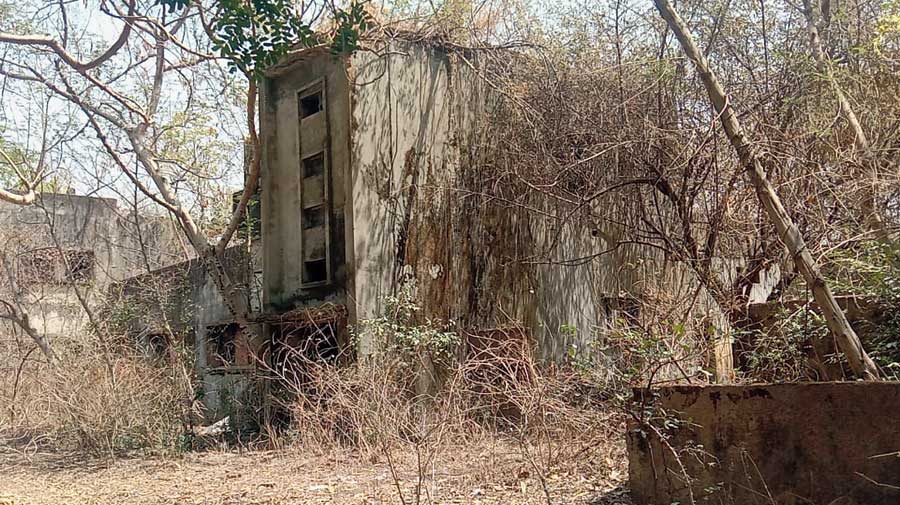Dhiram Pal Mehrolia lived for four years with the hope that Hindustan Cables Ltd (HCL), closed since 2017, would clear his dues.
The 64-year-old was among the scores of retrenched employees of the shuttered central public sector unit who had spotted light at the end of the tunnel when Union minister Babul Supriyo had promised to revive HCL and ensure that the staff got their dues.
During his election campaign for the Asansol Lok Sabha seat in 2014, Supriyo had said he had grand plans for turning around the limping central PSU. Three years after Asansol had voted him, the curtains came down on HCL and the likes of Mehrolia lost their livelihood.

The closed HCL plant. Santosh Kumar Mandal
Although every election comes with a plethora of promises on the future of the company on which the local economy used to thrive, Mehrolia said he would not make the same mistake.
Mehrolia said Prime Minister Narendra Modi had promised in his election speech at Asansol’s Nigha recently to resuscitate the glorious past of this industrial region, but the ex-employee did not dare raise his hopes.
Instead, he had several questions for the Prime Minister and his men who visited the area to seek votes for the BJP.
“Let the Prime Minister first answer why so many CPSUs are either closed or sick in the Durgapur-Asansol belt. We want to know what the Centre has done to ensure that the companies stay afloat,” Mehrolia had said before he cast his vote.
The HCL factory at Rupnarayanpur near Asansol stopped production in 2003 because of chronic losses and was finally declared shut in 2017. All 500 employees were given voluntary retirement.

The locked gate of the HCL factory Santosh Kumar Mandal
“I no longer hope the plant will reopen. I didn’t get salary in the past two years (2016 and 2017). Neither did I receive my gratuity and PF for this period. My question is, will the government clear my dues?” Mehrolia asks. He used to draw a monthly salary of Rs 22,000 as supervisor at HCL.
He said the provident fund and gratuity of around Rs 15 lakh that he had received after the closure of the company had been spent on the education of his two sons and daughter. “The only positive news is that my elder son has got a job at a private cement company after completing civil engineering. My younger son and daughter are still studying,” Mehrolia said.
He had taken an education loan of around Rs 2 lakh from a bank that his elder son Akash is repaying now.
“The quality of our lives has been so badly affected. Look at the dilapidated HCL quarters where we live in Rupnarayanpur. Basic amenities like electricity and water supply are so irregular. Is this a life?” Mehrolia asked.
Charanjit Singh, a former HCL employee and Intuc leader, said: “The town’s economy used to depend on our factory when it was booming. The gloomy story started in 2003 after the production had been halted. But the employees used to get their salaries regularly. Babul Supriyo made so many promises, but we feel cheated as he couldn’t stop the closure of HCL, leave alone revamping the company.”
HCL is not alone. The list of closed factories, including private units and CPSUs, in this region once known as the Ruhr of Bengal is long. The Ruhr Valley in Germany is an industrial hub.
“Most big industries are closed. People here don’t have jobs. They either work in illegal coal mines or slog it out as day labourers at small factories,” said Pradip Sarkar, former employee of the closed Burn Standard Company Ltd in Burnpur.
The Modi cabinet approved the closure of the railway wagon manufacturing unit in 2018.
The list of closed units in West Burdwan also includes Mining Allied and Machineries Corporation, Hindustan Fertiliser Corporation Ltd, Bharat Ophthalmic Glass Ltd, Cycle Corporation of India, Pilkington Glass, British Oxygen, Reckitt & Coleman, Kulti Sponge Pipe Factory and several coal mines.
Against this backdrop, the main issue in the nine Assembly seats with around 23 lakh voters and went to the polls on April 26 was the industrial decline in the region.
Trinamul’s coal sector trade union leader Hareram Singh, who contested from Jamuria, said the BJP might have tried to spin a “Sonar Bangla dream” but people in the area didn’t believe the claim as the extent of job losses had been the maximum since 2014.

Dilapidated quarters at the HCL township. Santosh Kumar Mandal
Chief minister Mamata Banerjee had in her campaigns in adjoining Bankura and Purulia laid down what her government was doing to ensure industries came up in Asansol-Durgapur so that the problem of unemployment was addressed. She attacked the Modi government for the closer of CPSUs as well as the attempt to privatise BSNL, the railways and other government-run units.
“The reopening of closed CPSUs is not in my hands as they are under the Centre’s control. We are setting up an industrial corridor starting from Panagarh in West Burdwan to Raghunathpur in Purulia, covering Bankura. The entire region, which includes West Burdwan, Birbhum, Bankura and Purulia, will come up as an industrial hub,” Mamata said.
In 2016, Trinamul had won six of the nine seats while the CPM-Congress combine had bagged three. However, in the 2019 general election, the BJP led in all Assembly segments. The BJP won the Asansol and Burdwan-Durgapur Lok Sabha seats in the district.
Trinamul leaders believe the large number of non-Bengali voters and the party’s organisational deficiencies helped the BJP polarise people along communal lines.
“The district has a sizable number of Hindi-speaking voters who work in coal mines and CPSUs. These people who originally hail from Bihar and Uttar Pradesh have been polarised. In some pockets, there are tribal voters who, too, shifted loyalties to the BJP since the 2018 rural polls,” a Trinamul leader in Asansol said.
The CPM’s strength is heavily depleted in the area that was once a red bastion.
The CPM candidate of Durgapur (East), Abhash Roy Choudhury, said Trinamul and the BJP were two sides of the same coin.
“They both have made polarisation their main plank while we are telling people about our plans to generate employment. People want work and money in their hands. We need to handle this pandemic properly,” he says.
BJP sources said though initially there had been a strong undercurrent in favour of the party across the district, developments such as the induction of former Asansol mayor and Trinamul’s sitting MLA Jitendra Tiwari had not gone down well with many party old-timers.










